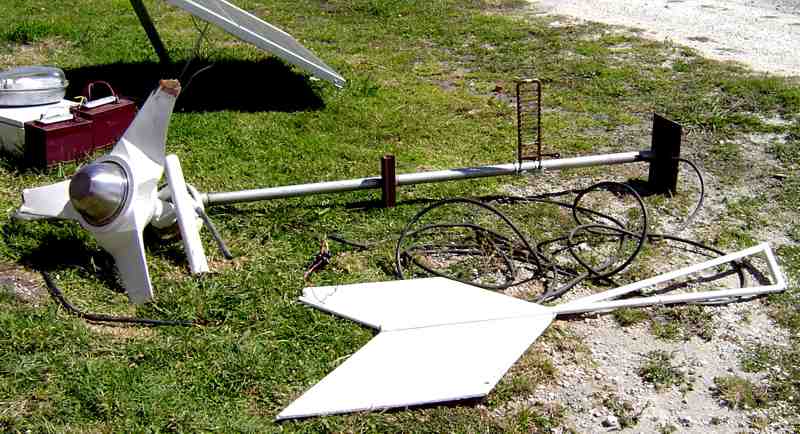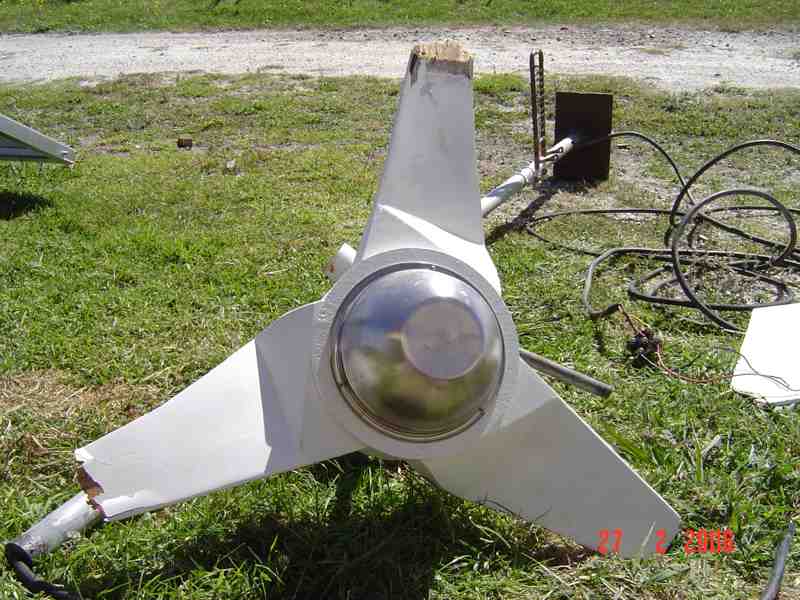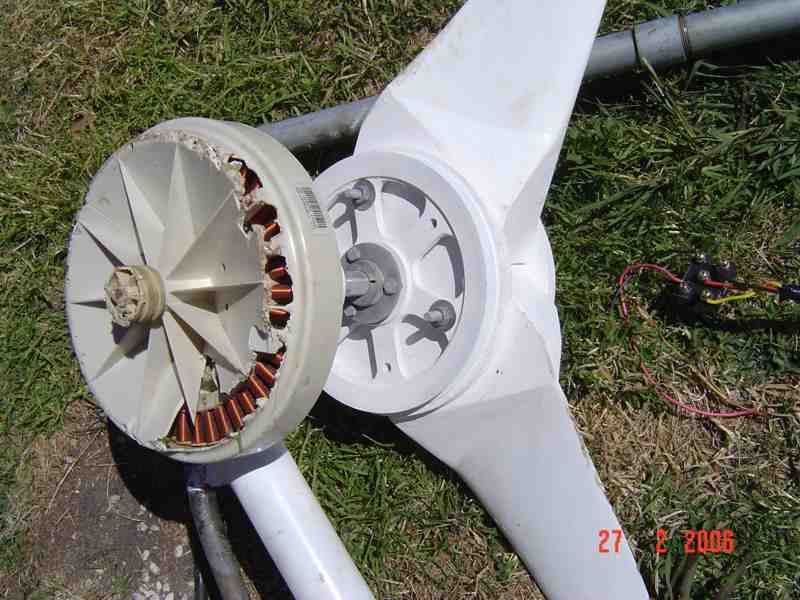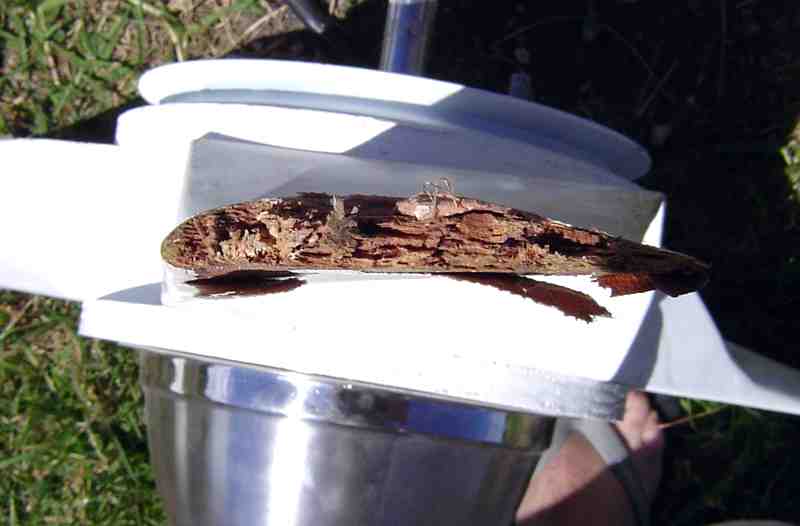Some time ago I built a 2m smartdrive based turbine to provide power for a remote wireless repeater. The build was a bit of a rush (I needed broadband!) and the machine basically got put into service as soon as it was turning. The smartdrive motor on which the alt was based uses 1mm windings and was left basically stock standard (no rewiring, star connected). I have played extensively with smartdrives over the last 4 years, but never before put one to use in a permanent turbine - I have been more focused on something that might provide a significant portion of my household needs. As those of you familiar with the smartdrive know, the stock standard motor is no good as an alt without first rewiring as it as its voltage goes up way too quick and it stalls at cutin. To get around this problem with the standard motor - and because its been an interest of mine - I made up a (kind of) MPPT controller/regulator. This basically used PWM to vary the load that the alt sees, connecting and disconnecting the battery to the alt at around 1kHz. This is not what would normally be considered a 'true' MPPT as it did not include an inductor in series with the battery to keep the voltage on the turbine side high i.e the turbine is dragged down to battery voltage every time its connected - 1000 times per second. This worked well to match the prop to the alt, but did nothing to address the large losses due to voltage mismatching. However because the load the turbine was only supplying was 2A max (while I was actually using the internet, going to sleep otherwise) and was being installed in a very exposed, windy location, I was happy that it just worked. The intention was to pull it down at a later date, finish it off and do some testing.
I finally got around to retrieving the turbine about three weeks ago - leaving the batteries in place for me to drive up and recharge with the vehicle every few days...
While the turbine was up, I did some simulation in circuitmaker using an inductor to match the voltages between the blades and alt. I came up with a circuit that seemed to work in theory and went about building it. I made a 100uH (calculated) air cored inductor that looks surprisingly like one of the coils you find in our dual rotor alts... It came out at around 0.1 Ohms. I used a bunch of 200V P Fets in a typical buck regulator configuration but when I actually built the circuit I found my fet gate drive lacking and had trouble getting over 1kHz without overheating. At 1kHz my poor 100uH inductor has a hard time controlling the voltage and I was getting about 50% ripple with a 100w load. After asking around I came up with an alternative gate drive circuit that allowed me to get to 10kHz without too much trouble. Once again I was keen to get out and test things before I had properly finished so I whacked on a pot so I could manually vary the pulse width and took her for a burl (manual control allowed me to put off the non-trivial task of developing a suitable algorithm for automatically finding the max power point).
I mounted the turbine on a 2.5m pole mounted at the rear of my tandem trailer. This put the bottom of the blades some half a meter above the roof line of my vehicle and some four meters behind. It also meant that the top of the blades extended almost 4m above ground level. I made a number of runs with the turbine not attached to a load before having to retire due to lack of light. Unloaded the turbine spun up to around 1200rpm @ 40kph where it started furling with a TSR of about 11 (designed at 7). As is typical of the smartdrive, start up occurred at around 30kph but would spin quite happily down to around 10kph after it had got going.
The following day after the help I had arranged did not arrive, I went about testing the turbine under load by myself. I decided to make a few quick runs just to make sure the basic functionality of the MPPT was OK. Initial results looked very encouraging, voltage was staying high on the turbine side and I was getting good current into my 12V battery. I could noticeably vary the load on the prop by cranking the pot (varying the pulse width). At this point I had not recorded any figures, but rather was just making sure things were alright overall. Now, the area I live in is a hilly rural location with winding, reasonably narrow roads with lots of trees, shrubs, scrub etc along the verge. I decided to test the MPPT under a reasonable load so I increased my speed to around 35kph (10m/s or 22mph) and tweaked the pot. I managed close to 60amps into the battery while maintaining around 60Vrms on the turbine side. Even though the battery was fairly well flat, the voltage was a steady 14V indicating the dump load was working. I was really excited, it seemed to be doing what it was meant to be doing! This output was only maintained for maybe only 10 seconds but I did notice a hot smell coming from the seat next to me. I leant over and sure enough the fets with their minimal (temporary) heatsink were do'in it pretty hard. I leant further to disconnect the entire circuit from the turbine and in doing so drifted a bit close to the side of the road. Now don't get me wrong, I was in no danger of leaving the road, I merely went closer than I intended. It just so happens that on this particular stretch of road there are some trees that overhang. Of course the trees over hung just far enough to clip the blades as they roared on by. The net result was that the entire turbine got wrenched around and toppled the pole on which it was mounted. The whole setup then promptly meet the road with the blades rapidly loosing length as the unforgiving tar seal refused to give way beneath them.
No more testing.
The whole mess after I retrieved it:

My brand new 24" blade set...

A slightly worse for wear smartdrive:

Not a bad aerofoil section tho...
